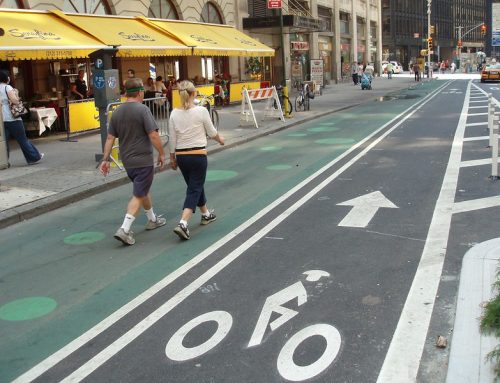In this article, we will be talking about bicycle safety and some of the advancements that have been made over the past 12 months. In 2024, several initiatives and technologies are being implemented to increase safety for bicyclists. Some of these include:
1. Legislative Changes: In California, a new bill (A.B. 1909) allows bicyclists to cross the street at the same time as pedestrians, providing them with greater safety from motor vehicles[2][3].
2. Infrastructure Development: Cities are focusing on building complete bike networks, low-stress bike connections, and adding bicycle signage and pavement markings to prioritize navigation for cyclists. There is also an emphasis on creating secure bike parking to encourage cycling as a mode of transportation[1].
3. Technological Innovations: Some cities are exploring the use of forward-facing cameras on city-owned vehicles to support the safety of bicyclists[3].
4. Enforcement Operations: Law enforcement agencies are conducting bike and pedestrian safety enforcement operations with focused enforcement efforts to ensure compliance with traffic laws and enhance safety[5].
These efforts reflect a multi-faceted approach to improving bicyclist safety, encompassing legislative, infrastructure, technological, and enforcement measures.
Citations:
[1] https://www.smartcitiesdive.com/news/building-bike-friendly-city/695249/
[2] https://www.bicycling.com/news/a46341796/california-cyclists-can-now-cross-the-street-at-the-same-time-as-pedestrians-that-matters/
[3] https://www.sfmta.com/blog/new-state-laws-are-coming-streets-san-francisco
[4] https://waba.org/blog/2024/01/2024va/
[5] https://www.santamonica.gov/press/2024/01/09/bicycle-and-pedestrian-safety-operation-planned-for-january-11-2024
The 5 E’s of Bicycle Infrastructure: Creating a Pedal-Friendly World
When it comes to making our roads safe and efficient for bikes, there’s a handy guide called the “5 E’s of Bicycle Infrastructure.” Let’s break it down and see how each of these “E’s” helps create a world where biking is safe and easy.
The origin of the 5 E’s
The 5 E’s framework was developed as a comprehensive approach to address the multifaceted challenges of integrating bicycles into urban and suburban landscapes. While the specific originator may not be pinpointed to a single entity, it gained prominence through the collaborative efforts of urban planners, transportation engineers, and advocacy groups passionate about enhancing cycling infrastructure.
- Engineering: The “Engineering” aspect focuses on the physical layout of roads and transportation networks. This involves the design and implementation of bike lanes, dedicated paths, and intersections that prioritize the safety and convenience of cyclists. Proper engineering ensures that cycling becomes an integrated and accessible part of the overall transportation infrastructure.
- Education: “Education” plays a vital role in fostering a shared understanding of the rules of the road among cyclists and motorists alike. Public awareness campaigns, school programs, and educational materials contribute to creating a culture of responsible behavior, ultimately enhancing safety for everyone on the road.
- Enforcement: The “Enforcement” component emphasizes the importance of upholding and enforcing laws related to bicycling and road safety. Law enforcement efforts work to ensure compliance with traffic regulations, promoting a harmonious coexistence between cyclists and motorized vehicles.
- Encouragement: To make cycling an attractive choice for commuting, “Encouragement” initiatives come into play. Community events, bike-sharing programs, and promotional campaigns work together to motivate more individuals to embrace cycling as a safe and healthy mode of transportation.
- Evaluation: “Evaluation” is an ongoing process that assesses the effectiveness of bicycle infrastructure and related programs. Are the paths working? Are people biking more? This helps us make ongoing improvements.
The 5 E’s of Bicycle Infrastructure provide a workable framework that communities can adopt to create an environment where cycling is not just a mode of transportation but a way of life. By addressing engineering, education, enforcement, encouragement, and evaluation, we pave the way for a pedal-friendly world that promotes health, and a sense of community on our roads.
The popularity of bicycling has increased for several reasons, including health, cost, and environmental factors. The rising number of cycling events, government initiatives, and the growing health consciousness among consumers have contributed to the increased demand for bicycles. Additionally, the COVID-19 situation led to a surge in bike sales due to heightened anxiety over public transportation, the closure or limitation of other recreational options, and the desire for a socially distant and healthy alternative for commuting and exercise.
Also, the cost of owning and maintaining motor vehicles, coupled with the environmental benefits of cycling, has also influenced the growing popularity of bicycling. The bicycle industry is experiencing significant growth, and urban mobility is changing rapidly, indicating that the trend of increased bicycling is likely to continue.
Advancements in Bicycle Technology: Riding into the Future
Technological innovations are reshaping the bicycling landscape. From smart bikes to advanced safety features, the industry is embracing technology to enhance the cycling experience. Some cities are exploring the use of forward-facing cameras on city-owned vehicles to support the safety of bicyclists, showcasing a commitment to integrating technology for improved safety.
Bicycle Safety in 2024
Bicycle safety and accidents have been the subject of various statistics and reports. The data indicates a mixed picture in terms of trends:
- Fatality and Serious Injury Trends: According to the U.S. Department of Transportation’s Fatality Analysis Reporting System, the risk of a fatality or serious injury for cyclists fell by 24% from 2019 to 2020 and 30% from a baseline of – 2% increase in slight casualties to cyclists in 2020, despite a 46% increase in total cycling. However, the number of bicyclist deaths has increased by 55% since reaching its lowest point in 2010.
- Legislative Efforts: In 2024, there are ongoing efforts to push a comprehensive bicycling safety agenda in various states, such as Virginia, which includes initiatives like the Safety Stop and allowing bicyclists to ride side-by-side in vehicle travel lanes.
- Injury Trends: A report by the U.S. Consumer Product Safety Commission (CPSC) indicates that injuries associated with e-scooters, hoverboards, and e-bikes have been increasing, with micromobility-related injuries trending upward since 2017, increasing an estimated average of 23% annually.
In summary, while there have been improvements in some aspects of bicycle safety, such as a reduction in the risk of fatality or serious injury, the overall trend in bicyclist deaths and injuries is not consistently decreasing. Ongoing efforts in legislative and safety initiatives reflect a continued focus on improving bicycle safety.
The Common Causes of Bicycle Accidents
The most common causes of bicycle accidents include:
- Collisions with Motorists: According to the National Highway Traffic Safety Administration (NHTSA), getting hit by a car is the most common cause of bicycle accidents, often resulting in severe injuries and fatalities.
- Falls: Accidents resulting from falls are also a common cause of bicycle accidents, accounting for a significant percentage of incidents.
- Road Conditions: Poor road conditions, such as potholes, uneven surfaces, or debris, can contribute to bicycle accidents.
- Rider Error: Mistakes made by cyclists, such as losing control of the bicycle, riding at high speeds, or navigating roadways with little experience, can lead to accidents.
- Environmental Factors: Weather conditions, such as rain, snow, or ice, can increase the risk of bicycle accidents.
- Collisions with Fixed Objects: Striking a fixed object or swerving to avoid an animal are also cited as common causes of bicycle accidents.
It’s important for both cyclists and motorists to practice safety and be aware of these common causes to help prevent accidents.
Safety Gear to Consider Purchasing
Some safety gear that can help prevent bicycle accidents includes:
- Helmets: Wearing a properly fitted helmet is essential to reduce the severity of head and brain injuries in the event of a crash.
- Reflective Gear and Lights: Using headlights, taillights, reflectors, and wearing reflective clothing increases visibility, especially when cycling at night or in low-light conditions, reducing the risk of accidents.
- Protective Eyewear: Shatter-resistant protective eyewear can help protect the eyes in the event of a crash.
- Gloves: Gloves can prevent painful shredding of skin during a fall and provide a better grip on the handlebars.
- Elbow and Knee Pads: These can protect against major scrapes and bruises in the event of a fall.
- Other Helpful Equipment: Carrying a tire pump, tire levers, patch kit, spare tube, water, identification, a cell phone, and using a mirror for improved awareness is also recommended for safety.
Wearing the proper safety gear is crucial for preventing accidents and minimizing the risk of injury while cycling.
Community Engagement: The Heartbeat of Bicycle Safety Initiatives
Fostering a sense of community engagement is vital for the success of bicycle safety initiatives. Community events, awareness campaigns, and collaborative efforts between local residents, advocacy groups, and policymakers contribute to building a supportive and bike-friendly environment. Highlighting successful community-driven initiatives can inspire others to actively participate in creating safer streets for everyone.






